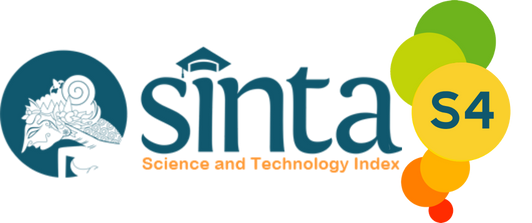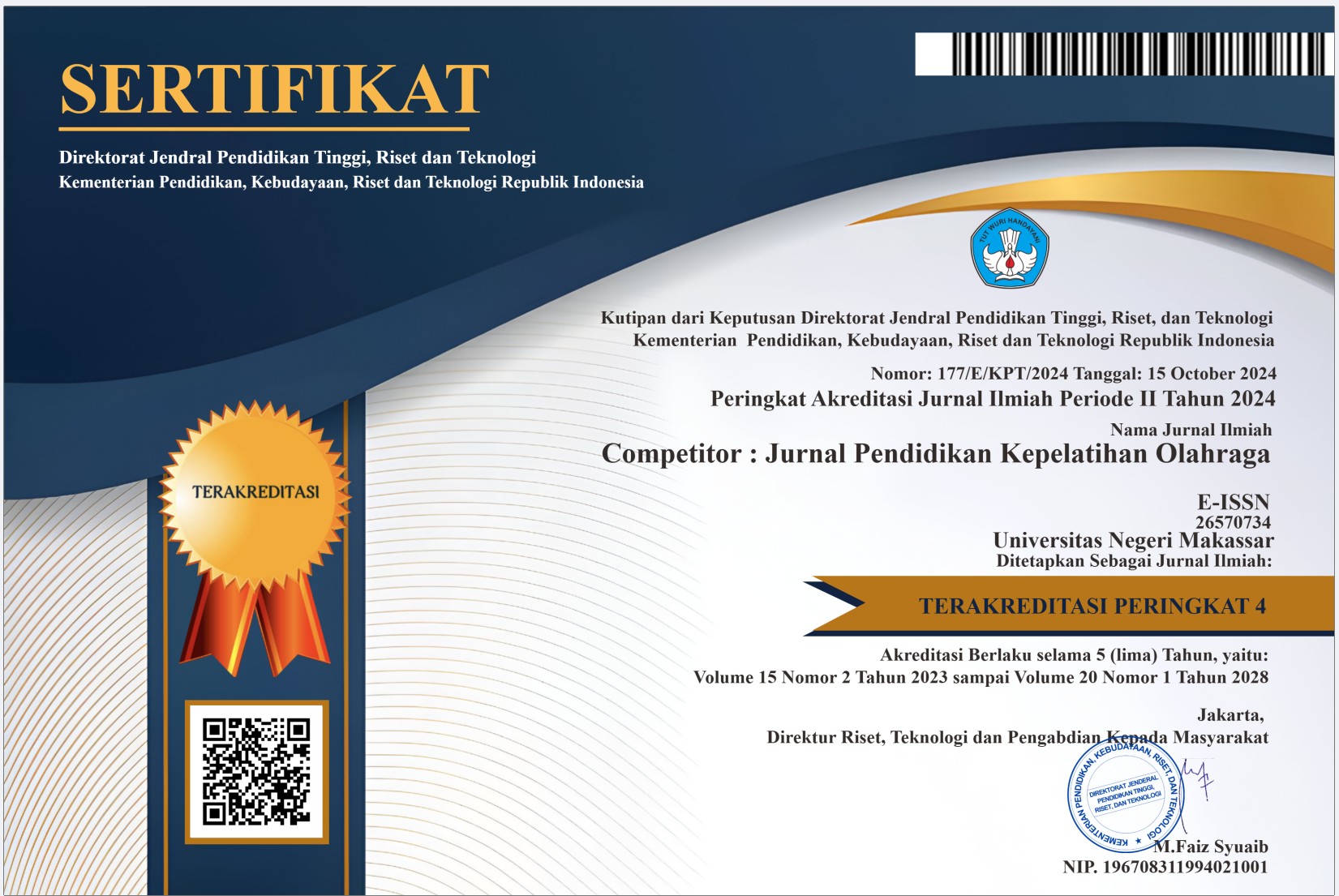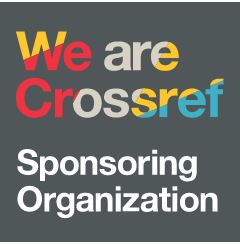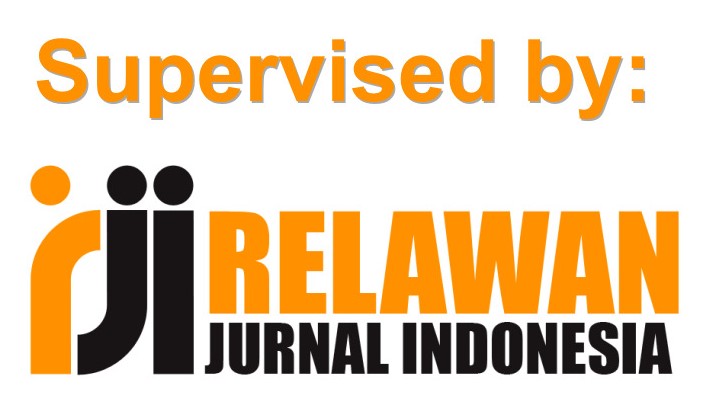The Impact of 30-Minute Jogging Before Iftar on University Students' Mood States During in Ramadan
DOI:
https://doi.org/10.26858/cjpko.v17i1.73484Keywords:
Fasting, Aerobic, Mood States, Mental HealthAbstract
This study investigates the impact of 30-minute aerobic exercise before iftar on the mood states of university students during Ramadan. Fasting during Ramadan poses physiological and psychological challenges, including fatigue, irritability, and decreased mood. While previous studies have explored the negative impacts of fasting on mood, limited research has focused on the potential benefits of aerobic exercise in alleviating these effects. A total of 21 male university students aged 18-23 (mean age = 19.0 years), with a mean body weight of 57 ± 7.39 kg and a mean height of 163.76 ± 7.45 cm, participated in this study. They engaged in moderate-intensity jogging (60-70% of their maximum heart rate) for 30 minutes, three times per week, during Ramadan. The Profile of Mood States (POMS) questionnaire was used to measure mood changes across six subscales: tension, anger, fatigue, depression, vigor, and concentration. The Shapiro-Wilk test confirmed normality of the data, and One-Way ANOVA was used to assess significant mood changes. The results showed significant reductions in negative mood states such as tension, anger, fatigue, and depression, and a notable increase in vigor. Conditions such as tension, anger, fatigue, and depression, as well as a significant increase in enthusiasm. Not only that, there is an increase in concentration. The findings of this study indicate that doing aerobic exercise before breaking the fast can improve mood and concentration well during the Ramadan fast, so this exercise offers a practical solution to support the mental and physical health of fasting students.References
Al-Hariri, M., Khan, S., Albaker, W., & Al Malik, W. (2019). Impact of Knowledge and Practice on Fasting Blood Glucose Levels among Diabetics During Ramadan Fasting. Journal of Epidemiology and Global Health, 9(4), 288. https://doi.org/10.2991/jegh.k.190824.001
Amekran, Y., Damoun, N., Taiek, N., & El Hangouche, A. J. (2023). Effects of aerobic training on heart rate variability in healthy adults: a systematic review. Gazzetta Medica Italiana Archivio per Le Scienze Mediche, 182(7–8). https://doi.org/10.23736/S0393-3660.23.04952-5
Basso, J. C., Oberlin, D. J., Satyal, M. K., O’Brien, C. E., Crosta, C., Psaras, Z., Metpally, A., & Suzuki, W. A. (2022). Examining the Effect of Increased Aerobic Exercise in Moderately Fit Adults on Psychological State and Cognitive Function. Frontiers in Human Neuroscience, 16. https://doi.org/10.3389/fnhum.2022.833149
Berthelot, E., Etchecopar-Etchart, D., Thellier, D., Lancon, C., Boyer, L., & Fond, G. (2021). Fasting Interventions for Stress, Anxiety and Depressive Symptoms: A Systematic Review and Meta-Analysis. Nutrients, 13(11), 3947. https://doi.org/10.3390/nu13113947
Beserra, A. H. N., Kameda, P., Deslandes, A. C., Schuch, F. B., Laks, J., & Moraes, H. S. de. (2018). Can physical exercise modulate cortisol level in subjects with depression? A systematic review and meta-analysis. Trends in Psychiatry and Psychotherapy, 40(4), 360–368. https://doi.org/10.1590/2237-6089-2017-0155
Crush, E. A., Frith, E., & Loprinzi, P. D. (2018). Experimental effects of acute exercise duration and exercise recovery on mood state. Journal of Affective Disorders, 229, 282–287. https://doi.org/10.1016/j.jad.2017.12.092
Daniela, M., Catalina, L., Ilie, O., Paula, M., Daniel-Andrei, I., & Ioana, B. (2022). Effects of Exercise Training on the Autonomic Nervous System with a Focus on Anti-Inflammatory and Antioxidants Effects. Antioxidants (Basel, Switzerland), 11(2). https://doi.org/10.3390/antiox11020350
Edwards, M. K., Rhodes, R. E., & Loprinzi, P. D. (2017). A Randomized Control Intervention Investigating the Effects of Acute Exercise on Emotional Regulation. American Journal of Health Behavior, 41(5), 534–543. https://doi.org/10.5993/AJHB.41.5.2
Farooq, A., Chamari, K., Sayegh, S., El Akoum, M., & Al-Mohannadi, A. S. (2021). Ramadan daily intermittent fasting reduces objectively assessed habitual physical activity among adults. BMC Public Health, 21(1), 1912. https://doi.org/10.1186/s12889-021-11961-9
Ferrer-Uris, B., Ramos, M. A., Busquets, A., & Angulo-Barroso, R. (2022). Can exercise shape your brain? A review of aerobic exercise effects on cognitive function and neuro-physiological underpinning mechanisms. AIMS Neuroscience, 9(2), 150–174. https://doi.org/10.3934/Neuroscience.2022009
Fry, A., & Putrino, D. (2018). Exercise decreases cardiovascular risk factors: Now what? International Journal of Cardiology, 254, 340–341. https://doi.org/10.1016/j.ijcard.2017.12.023
Grove, J. R., & Prapavessis, H. (1992). Preliminary Evidence for the Reliability and Validity of an Abbreviated Profile of Mood States. International Journal of Sport Psychology, 23(2), 93–109.
Herbert, C., Meixner, F., Wiebking, C., & Gilg, V. (2020). Regular Physical Activity, Short-Term Exercise, Mental Health, and Well-Being Among University Students: The Results of an Online and a Laboratory Study. Frontiers in Psychology, 11. https://doi.org/10.3389/fpsyg.2020.00509
Hossain, M. N., Lee, J., Choi, H., Kwak, Y.-S., & Kim, J. (2024). The impact of exercise on depression: how moving makes your brain and body feel better. Physical Activity and Nutrition, 28(2), 43–51. https://doi.org/10.20463/pan.2024.0015
Kandola, A., Vancampfort, D., Herring, M., Rebar, A., Hallgren, M., Firth, J., & Stubbs, B. (2018). Moving to Beat Anxiety: Epidemiology and Therapeutic Issues with Physical Activity for Anxiety. Current Psychiatry Reports, 20(8), 63. https://doi.org/10.1007/s11920-018-0923-x
Lessan, N., & Ali, T. (2019). Energy Metabolism and Intermittent Fasting: The Ramadan Perspective. Nutrients, 11(5), 1192. https://doi.org/10.3390/nu11051192
Liu, X., He, M., Gan, X., Yang, Y., Hou, Q., & Hu, R. (2023). The effects of six weeks of fasted aerobic exercise on body shape and blood biochemical index in overweight and obese young adult males. Journal of Exercise Science & Fitness, 21(1), 95–103. https://doi.org/10.1016/j.jesf.2022.11.003
Martin, M., Krystof, S., Jiri, R., Martina, D., Renata, V., Ondrej, M., Stepan, S., & Vladimir, T. (2016). Modulation of Energy Intake and Expenditure Due to Habitual Physical Exercise. Current Pharmaceutical Design, 22(24), 3681–3699. https://doi.org/10.2174/1381612822666160419144200
McDowell, C. P., Dishman, R. K., Gordon, B. R., & Herring, M. P. (2019). Physical Activity and Anxiety: A Systematic Review and Meta-analysis of Prospective Cohort Studies. American Journal of Preventive Medicine, 57(4), 545–556. https://doi.org/10.1016/j.amepre.2019.05.012
Meo, S. A., & Hassan, A. (2015). Physiological changes during fasting in Ramadan. JPMA. The Journal of the Pakistan Medical Association, 65(5 Suppl 1), S6–S14. http://www.ncbi.nlm.nih.gov/pubmed/26013791
Morres, I. D., Hatzigeorgiadis, A., Stathi, A., Comoutos, N., Arpin-Cribbie, C., Krommidas, C., & Theodorakis, Y. (2019). Aerobic exercise for adult patients with major depressive disorder in mental health services: A systematic review and meta-analysis. Depression and Anxiety, 36(1), 39–53. https://doi.org/10.1002/da.22842
Puterman, E., Weiss, J., Beauchamp, M. R., Mogle, J., & Almeida, D. M. (2017). Physical activity and negative affective reactivity in daily life. Health Psychology, 36(12), 1186–1194. https://doi.org/10.1037/hea0000532
Saddoud, A., Khacharem, A., H’Mida, C., Trabelsi, K., Boukhris, O., Ammar, A., Clark, C. C. T., Glenn, J. M., Chtourou, H., Jarraya, M., Rosemann, T., & Knechtle, B. (2021). Ramadan Observance Is Associated with Impaired Kung-Fu-Specific Decision-Making Skills. International Journal of Environmental Research and Public Health, 18(14), 7340. https://doi.org/10.3390/ijerph18147340
Skurvydas, A., Istomina, N., Dadeliene, R., Majauskiene, D., Strazdaite, E., Lisinskiene, A., Valanciene, D., Uspuriene, A. B., & Sarkauskiene, A. (2024). Mood profile in men and women of all ages is improved by leisure-time physical activity rather than work-related physical activity. BMC Public Health, 24(1), 546. https://doi.org/10.1186/s12889-024-17806-5
Skurvydas, A., Lisinskiene, A., Lochbaum, M., Majauskiene, D., Valanciene, D., Dadeliene, R., Fatkulina, N., & Sarkauskiene, A. (2021). Physical Activity, Stress, Depression, Emotional Intelligence, Logical Thinking, and Overall Health in a Large Lithuanian from October 2019 to June 2020: Age and Gender Differences Adult Sample. International Journal of Environmental Research and Public Health, 18(23), 12809. https://doi.org/10.3390/ijerph182312809
Wang, Y., & Wu, R. (2022). The Effect of Fasting on Human Metabolism and Psychological Health. Disease Markers, 2022, 5653739. https://doi.org/10.1155/2022/5653739
Zapalac, K., Miller, M., Champagne, F. A., Schnyer, D. M., & Baird, B. (2024). The effects of physical activity on sleep architecture and mood in naturalistic environments. Scientific Reports, 14(1), 5637. https://doi.org/10.1038/s41598-024-56332-7
Downloads
Published
Issue
Section
License
Copyright (c) 2025 Fifit Yeti Wulandari, Anung Priambodo (Author)

This work is licensed under a Creative Commons Attribution 4.0 International License.





















